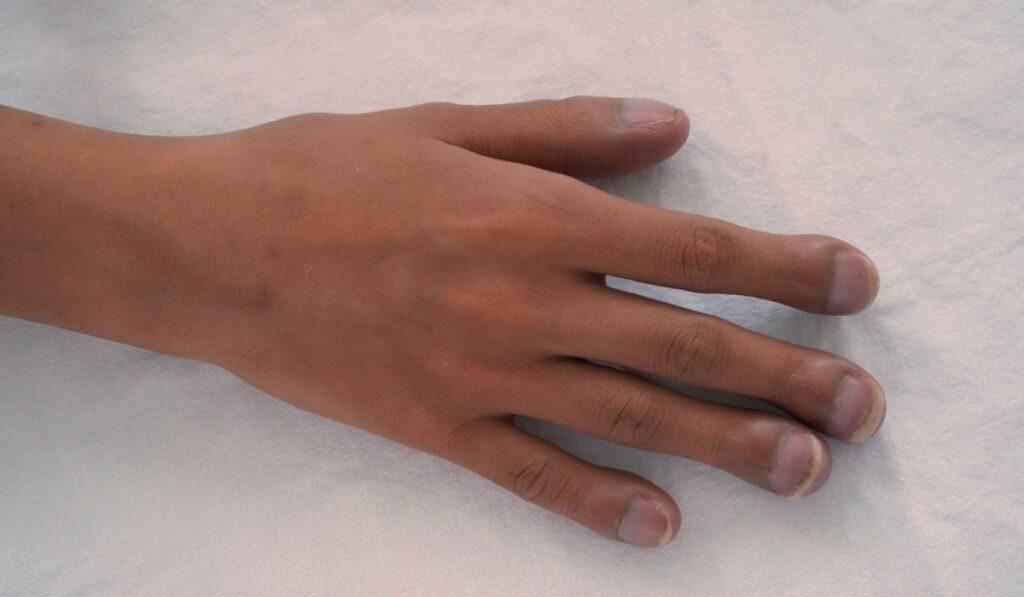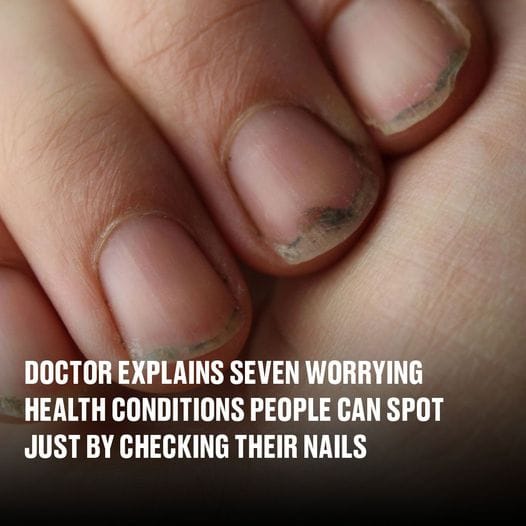You can learn a lot about a person by their fingernails, especially when it comes to health. Anomalies such as changes in shape and color can indicate medical conditions such as psoriasis, heart disease, and even cancer. But keep in mind that brittle or discolored nails are not typically a cause for alarm since they can come from injuries, dampness, poor nutrition, or age.
“For the general population, nail health is most often an indicator of poor nutritional intake or poor digestion,” explains Dr. Sara Norris, a naturopathic doctor based in Los Angeles. “Brittle, weak, and peeling nails are the most common concerns I see in my practice and these symptoms are more often the result of a poor diet than of systemic disease.”
So don’t panic if your nails resemble these descriptions. But if the issue doesn’t resolve on its own or if it accompanies other symptoms (like fatigue, weakness, swelling, heart palpitations, weight loss, etc.) speak to a medical practitioner.
Beau’s lines
 Image Credit: Shutterstock
Image Credit: Shutterstock
“Deep lines or grooves across your fingernails are known as Beau’s lines,” says Dr. Bhavini Shah of Lloyds Pharmacy Online Doctor. These lines appear when nail growth has briefly slowed or stopped. “This temporary disturbance of nail growth is usually caused by severe illness or infection. Some people developed Beau’s lines after they had COVID-19, for example.” In severe cases, the nail can stop growing long enough to form a full gap, which is medically known as onychomadesis. This can occur after major stresses like chemotherapy, injuries, and high fevers.
Beau’s lines can come and go without being a cause of concern but if it’s a recurring issue or you are experiencing onychomadesis, speak to your GP about what might be the cause.
Clubbing
 Image Credit: Shutterstock
Image Credit: Shutterstock
Clubbed fingernails also affect the fingertips. As the nails curve downward, the fingertips begin to swell and cause discomfort. This shift may not be noticeable since it can evolve over time. “Generally, red or purple lines under your nails are due to an injury. But if you notice these and don’t recall injuring your nail, you might want to book a doctor’s appointment because these can be a symptom of heart disease,” says Shah.
“Clubbing can also be a suggestion of heart disease, a major cause of death worldwide. This is where the nail curves over rounded fingertips or the ends of the toes, resulting in a bulbous appearance. Other symptoms that indicate heart disease include extreme fatigue, swollen ankles and pain in the chest, stomach, legs, arms, jaw or back.” Keep in mind that some people’s natural fingernails look clubbed.
Spooning
 Image Credit: American Association of Dermatology Association
Image Credit: American Association of Dermatology Association
“Spoon-shaped nails that curve inwards can be a sign of iron-deficiency anemia,” says Dr. Shah. “This condition is common after pregnancy and is where the level of iron in your blood is too low. Other symptoms include tiredness, shortness of breath, pale skin and headaches.” Iron deficiency could also occur because of lack of proper nutrition, celiac disease, or digestive issues.
“It’s important to identify the cause of iron deficiency anaemia so book an appointment with your GP if you have any concerns. Your GP may recommend a blood test to check your red blood cell count.” Fortunately, it’s relatively easy to treat anemia by eating iron-rich foods and taking iron supplements.
Pitting or denting
 Image Credit: Dermnet New Zealand
Image Credit: Dermnet New Zealand
“Small dents or pits on the surface of the nails are common in people with skin disorders such as psoriasis, eczema and alopecia areata (a specific type of hair loss),” according to Dr. Shah. “You’d expect other outward symptoms. For example, psoriasis typically causes dry, scaly patches of skin, while eczema causes the skin to become dry, itchy, cracked and sore. Alopecia areata involves patchy hair loss.”
A dermatologist could diagnose the cause of these indentations in the nails. For mild cases where the pitting is causing no discomfort, no treatment is usually needed. Some cases are treated with topical or injected corticosteroid and vitamin D3, often alongside treatment for the underlying condition causing it.
👇 To continue reading, scroll down and click Next 👇
ADVERTISEMENT

